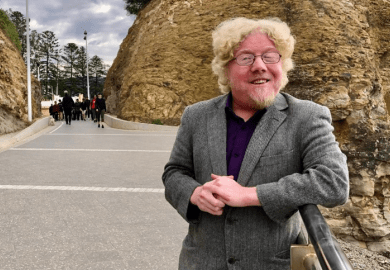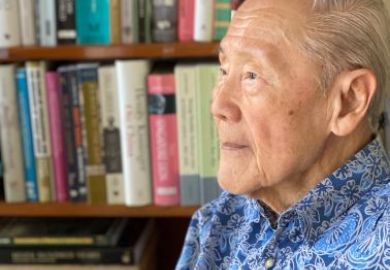Jemma Wadham is one of the world’s leading glaciologists and has led more than 25 expeditions to glaciers all over the world. She has been professor of glaciology at the University of Bristol since 2012 and now combines this with a similar position at UiT The Arctic University of Norway. Her first book aimed at a general readership, Ice Rivers, was published by Allen Lane earlier this year.
Where and when were you born?
Portsmouth in 1972.
How did your childhood shape you?
It was a bit of a confusing time as I lost my father in a car accident when I was 8, but I think through that I learned to draw upon nature for comfort and inspiration. I loved being in the hills and outdoors.
What kind of undergraduate were you?
I was interested in everything at the beginning of my studies as a geography student [at Selwyn College, Cambridge], from coral reefs to Cold War geopolitics. Then I met my first glacier aged 20: the Haut Glacier d’Arolla in Valais, Switzerland.
You describe Ice Rivers as ‘in many ways, a love story’. What led you to fall in love with glaciers?
What makes anyone fall in love? Fascination, inspiration, obsession, a sensory experience beyond what we ordinarily access – I guess it’s all those things. I experience every glacier differently, which is a product of their different features, the varied landscapes and climates which frame them and the intriguing questions they pose. I found it almost impossible to walk away from them and take another path.
How did you come to realise that glaciers are full of life?
Towards the end of my stay in Arolla, an interdisciplinary team of microbiologists, glaciologists and geochemists – including my future PhD supervisor – discovered active populations of bacteria living in mud in the dark depths of the glacier. It was astonishing and transformed our view of glaciers from sterile wastelands to places which were very much alive, just like our forests, soils and oceans.
Why is it crucial that multidisciplinary teams are involved in studying glaciers?
Glaciers are places where rock, ice, water and microbial life meet. For me, this means the most powerful way to study them is by collaboration across disciplines. The fact that glaciers are buzzing with life means that the meltwaters they release contain the chemical by-products of this life: nutrients digested from rock and even potentially harmful metals such as mercury or the greenhouse gas methane. We only realised this in the past two decades, and are now working hard to understand what it means for people and ecosystem services such as river water quality, fisheries and global climate.
Why do you say that fieldwork is fundamentally about ‘the business of survival’?
Most of my work has involved running field camps in remote areas at the foot of a glacier. We have to survive the – often dire – weather, generate our own power, set up and maintain field labs, prepare and cook food, learn to “deal with” the locals – from polar bears to musk oxen – stay warm and healthy, while keeping sane amid deep isolation. All this “surviving” takes a lot of time and energy.
What was the most frightening experience you recall?
Probably the polar bears of Svalbard. They are not something you can control. The time we had a visitation from two bears in the night in Svalbard, I honestly thought that was the end of my life. I can still recall the raw fear, my pounding heart and trembling legs as we tried to guess their next move and whether they would enter the hut in search of food.
What was it like to ‘witness the death of a glacier’ when you returned to the Alps 26 years after your first research trip?
I remember the excitement I felt as I climbed the path to our old camping spot. The memories flooded back. Then I peered up the valley to where the glacier had been in 1992, and all I saw was drab grey and brown rock – like a shroud of something that had met its fate. There was no glacier. It had retreated about one kilometre around the corner. It was an incredibly sad moment.
Your book makes vivid and personal the dry news reports of ‘waning glaciers’. What do you hope to achieve by this?
I’m not sure as human beings we act to save or help something unless we have a personal connection to it. I think what I wanted to do in writing Ice Rivers was to take people to the places I had experienced, to show them the glaciers and how they worked via an immersive journey. If that brings understanding and connection for people, then that’s a good thing.
How bad is the ‘acute health crisis’ glaciers are facing?
Mountain glaciers and our ice sheets are melting and thinning at accelerating rates, with impacts on river flows, sea level, ecosystems and the services they provide to us – it’s unprecedented in human history and is happening with over 7 billion people on the planet.
What led you to take part in an art project where you performed the role of a dying glacier?
I nearly lost my life at the end of 2018 and underwent emergency brain surgery. When I recovered, I felt like I had been given a second life. I felt strongly that I needed to communicate about our glaciers and what was happening to them, so I got up on stage – as a dying glacier at the Hay Festival in Peru, blue wig and all – and wrote Ice Rivers. They were different projects but both involved some level of what felt like personal risk but a desire to communicate in a new way. Compared with brain surgery, the risk didn’t seem such a big deal any more.
matthew.reisz@timeshighereducation.com
Appointments
Annamarie Jagose has been promoted to become provost and deputy vice-chancellor at the University of Sydney. Currently dean of Sydney’s Faculty of Arts and Social Sciences, the internationally renowned scholar in feminist studies and queer theory joined the university in 2011 as head of the School of Literature, Art and Media. “Annamarie brings a strong combination of leadership and management experience at the university, along with experience of leading change and shaping culture within complex academic environments,” said vice-chancellor Mark Scott.
Renée Leon has been appointed vice-chancellor of Charles Sturt University. A civil servant, she has been secretary in two Australian federal departments, most recently the Department of Human Services and previously the Department of Employment. Ms Leon “has demonstrated her skills in effectively running large and complex organisations with multiple stakeholders and is the right person to lead Charles Sturt University into the next stage of [its] development”, said chancellor Michele Allan.
Lionel Wee has been named as the next dean of the Faculty of Arts and Social Sciences at the National University of Singapore. He is currently vice-dean of research and professor of linguistics in the department of English language and literature.
Lerone Martin is joining Stanford University as director of the Martin Luther King, Jr Research and Education Institute. He is currently an associate professor of religion and politics at Washington University in St Louis.
Robert Gordon University has named Donella Beaton as vice-principal for economic development. She is currently associate vice-principal for business and economic development.
Jessica Gallagher will be the University of Adelaide’s new deputy vice-chancellor for external engagement. She is currently pro vice-chancellor (global engagement and entrepreneurship) at the University of Queensland.
Register to continue
Why register?
- Registration is free and only takes a moment
- Once registered, you can read 3 articles a month
- Sign up for our newsletter
Subscribe
Or subscribe for unlimited access to:
- Unlimited access to news, views, insights & reviews
- Digital editions
- Digital access to THE’s university and college rankings analysis
Already registered or a current subscriber?






